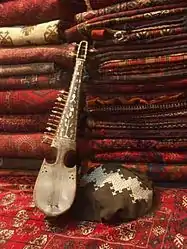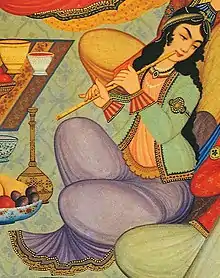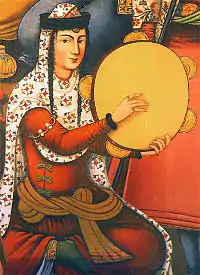Rubab (instrument)
Rubab, robab or rabab (Pashto: روباب, Persian: رُباب, Urdu: روباب, Kashmiri: روباب, Azerbaijani: Rübab, Turkish: Rübab, Tajik and Uzbek рубоб) is a lute-like musical instrument originating from Afghanistan.[1] The rubab is one of the national musical instruments of Afghanistan and other areas inhabited by the Pashtun and Baloch people.[2] It proliferated throughout West, Central, South and Southeast Asia.[3] It derives its name from Arabic rebab 'played with a bow'; in Central Asia, however, the instrument is plucked and is distinctly different in construction.
 | |
| Classification |
|
|---|---|
| Related instruments | |
| Sarod, Dutar, Tanbur | |
Size variants
Components
- Kassah or kasseh (Persian: کاسه) = bowl, shell
- Badanah or badaneh (Persian: بدنه) = body
- Safah or safeh (Persian: صفحه) = side
- Dastah or desteh (Persian: دسته) ('hand') = neck
- Goshi (Persian: گوشی) ('ear')= tuning peg
- Sheitanak ("little devil") (Persian: شیطانک) = nut
- Seemgeer (Persian: سیم گیر) ('wire-capture') = tailpiece
- Sar penjah or ser panjeh ("fifty heads") (Persian: سر پنجه) or taj (Persian: تاج) = headstock
- Pust (Persian: پوست) = head (usually goatskin)
- Kharak ("little donkey" or trestle) (Persian: خرک) = bridge
- Mezrab (Persian: مضراب) = plectrum
Construction

The body is carved out of a single piece of wood, with a head covering a hollow bowl which provides the sound-chamber. The bridge sits on the skin and is held in position by the tension of the strings. It has three melody strings tuned in fourths, two or three drone strings and up to 15 sympathetic strings. The instrument is made from the trunk of a mulberry tree, the head from an animal skin such as goat, and the strings from the intestines of young goats (gut) or nylon.
History
The rubab is known as "the lion of instruments" and is one of the two national instruments of Afghanistan (with the zerbaghali). Classical Afghan music often features this instrument as a key component. Elsewhere it is known as the Kabuli rebab. In appearance, the Kabuli rubab looks slightly different from the Indian rubab.[4] It is the ancestor of the north Indian sarod, although unlike the sarod, it is fretted.[5]
The rubab is attested from the 7th century CE. It is mentioned in old Persian books, and many Sufi poets mention it in their poems. It is the traditional instrument of Khorasan and is widely used in countries such as Afghanistan, Pakistan, Azerbaijan, Iran, Turkey, Iraq, Tajikistan, and Uzbekistan, as well as the Xinjiang province of northwest China and the Indian-administered territory of Jammu and Kashmir.[6]
The rubab was the first instrument used by Sikhism; it was used by Bhai Mardana, companion of Guru Nanak. Whenever a shabad was revealed to Guru Nanak he would sing and Bhai Mardana would play on his rubab; he was known as a rubabi. The rubab playing tradition is carried on by Sikhs such as Namdharis.
Variants
In Tajikistan a similar but somewhat distinct rubab-i-pamir (Pamiri rubab) is played, employing a shallower body and neck.[7] The rubab of the Pamir area has six gut strings, one of which, rather than running from the head to the bridge, is attached partway down the neck, similar to the fifth string of the American banjo.[8]
Notable players
.jpg.webp)
- Ustad Mohammed Omar (1905—1980), Rubab player from Kabul, Afghanistan
- Ustad Rahim khushnawaz(1945-2010), Rubab Player from Herat, Afghanistan
- Ustad Homayun Sakhi, rubab player from Kabul, Afghanistan
- Ustad Bagh-e-Aram Baba, Rubab player from Peshawar,Pakistan
- Ustad Ghulam Hussain, Rubab player from kabul,Afghanistan
- Ustad Amjad Malang, Rubab player from Peshawar, Pakistan
References
- David Courtney, 'Rabab', Chandra & David's Homepage
- The Wide World Magazine: An Illustrated Monthly of True Narrative, Adventure, Travel, Customs and Sport ... A. Newnes, Limited. 1905. pp. 15–.
- Miner, Allyn (2004). Sitar and Sarod in the 18th and 19th Centuries. Motilal Banarsidass Publications. p. 61. ISBN 9788120814936.
- Kak, Siddharth (1982). Cinema Vision India, Volume 2. Siddharth Kak. p. 25.
The rubab of Kabul is very similar to the sarod. The Indian rubab looks different. The sarod is a blend of these two rubabs.
- Simon Broughton. "Tools of the Trade: Sarod". Songlines-The World Music Magazine. Archived from the original on 2006-11-18.
- http://www.nadsadhna.com/pages/indianmusic/IndianInstruments.asp?About=Rabab
- "Pastimes of Central Asians. A Musician Playing a Rubab, a Fretted Lute-like Instrument". World Digital Library. Retrieved 14 May 2014.
- Music and Poetry from the Pamir Mountains Musical Instruments, The Institute of Ismaili Studies.
External links
| Wikimedia Commons has media related to Rubab. |
- Video, rubab being played. Part of performance is slide rubab, like slide guitar.
- Farabi School
- World Music Central - Ustad Mohammad Omar
- Music of the Uyghurs
.jpg.webp)

